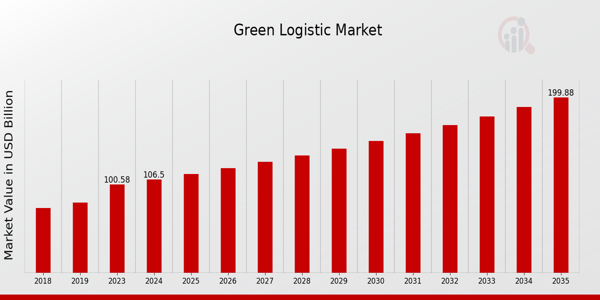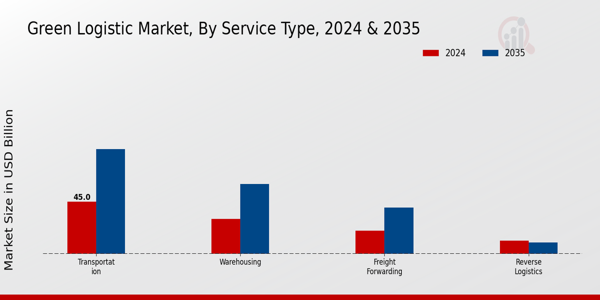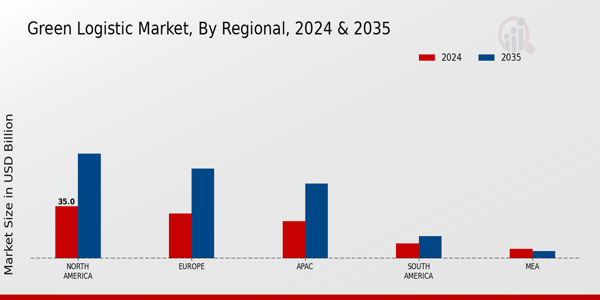Green Logistic Market Overview:
As per MRFR analysis, the Green Logistic Market Size was estimated at 100.58 (USD Billion) in 2023. The Green Logistic Market Industry is expected to grow from 106.5(USD Billion) in 2024 to 200.0 (USD Billion) by 2035. The Green Logistic Market CAGR (growth rate) is expected to be around 5.89% during the forecast period (2025 - 2035).
Key Green Logistic Market Trends Highlighted
The Green Logistics Market’s growth can be attributed to a number of factors across the globe. From the rise in technological advancements that include pollution monitoring, automated inventory, and other similar devices to the stricter requirements on carbon emissions to accommodate the change in consumer behavior towards green products. The dire need for consumers to adopt practices to promote sustainability has led to this shift towards green logistics. Organizations are making great efforts by switching to electric and hybrid vehicles which is a significant step in achieving a sustainable world. There is no doubt that the Green Logistics industry is destined for a great growth trajectory given the number of organizations promoting sustainable practices.
Green logistics focus on practices that maximize resource and energy efficiency which results in a decrease in supply chain costs. The emphasis on environmental sustainability has led consumers to favor organizations that practice green logistics, this practice has enabled companies to save costs and expand their brand image. Other than this green logistics require coalitions with ICT providers that foster innovation. The Global Green Market is also witnessing an increased trend towards IoT and data analytics that encourage real time updates of the tasks alongside automation of manual labor. This helps cut down costs and improves the efficiency of the business in the long slot of time.
Furthermore, supply chain resilience has emerged as a significant issue prompting companies to consider new transportation options including rail and sea freight to reduce emissions. In addition, the adoption of circular economy principles becomes essential as companies aim to reduce consumption of resources during the logistical process. In view of these pro-sustainable trends, the market is likely to change considerably and hence the large space for growth and innovation means that firms are motivated to change their logistics patterns to much more sustainable ones.

Green Logistic Market Drivers
Growing Environmental Concerns
The Global Green Logistic Market Industry is significantly driven by the rising environmental awareness among consumers, businesses, and governments. As the effects of climate change become increasingly evident, there is a growing emphasis on sustainability across various sectors. Companies are now prioritizing eco-friendly practices in their operations, especially in logistics, where transportation and supply chain activities contribute to a substantial carbon footprint.This shift is prompted by the need to comply with evolving regulations aimed at reducing greenhouse gas emissions, which increasingly challenge traditional logistics operations. Furthermore, corporate social responsibility (CSR) initiatives are influencing enterprises to adopt greener practices, not just for ethical reasons but also to build a more favorable brand image among environmentally conscious consumers. The pressure to implement sustainable logistics solutions has given rise to a variety of innovations, such as electric vehicles, energy-efficient transportation methods, and optimized supply chain management strategies.This eco-centered transformation is essential for businesses seeking to remain competitive in the labor market and among their consumers. The anticipated growth of the Global Green Logistic Market indicates that companies are recognizing the financial advantages of operational efficiencies achieved through sustainable logistics. Investments in green technologies and practices position businesses for better long-term profitability, paving the way for a stronger focus on sustainability in logistics and beyond, making it a dominant driver of the market.
Regulatory Pressure and Compliance Initiatives
The Global Green Logistic Market Industry is increasingly influenced by stringent regulatory measures and compliance initiatives imposed by governments and international organizations. These regulations are designed to minimize environmental impact by enforcing limits on emissions, waste, and energy consumption in logistics operations. With an escalating commitment to combat climate change, various jurisdictions are mandating green certifications and eco-friendly logistics solutions as prerequisites for operation within their markets.This trend compels companies to invest in green technologies and practices, ensuring compliance with these emerging regulations. As businesses adapt, they not only mitigate the risk of penalties but also enhance their reputation as environmentally responsible entities, driving demand for green logistics services.
Technological Advancements in Logistics
Technological advancements are significantly propelling the Global Green Logistic Market Industry forward. Innovations in the logistics sector, such as automation, IoT integration, and data analytics, enable companies to enhance supply chain efficiencies while minimizing their environmental impact. Automation reduces human error and resource wastage, while IoT and data analytics provide real-time insights, optimizing routing and inventory management.This leads to a reduction in fuel consumption and waste. As businesses increasingly leverage these technologies, their operations become more sustainable without sacrificing efficiency. The ongoing research and development in green technologies not only supports logistics capabilities but also contributes to the overall credibility of the Global Green Logistic Market as a future-oriented industry.
Green Logistic Market Segment Insights:
Green Logistic Market Service Type Insights
The Global Green Logistic Market is progressively evolving, particularly in the area of service types, which include Transportation, Warehousing, Freight Forwarding, and Reverse Logistics. By 2024, the revenue for the Transportation segment is expected to reach 45.0 USD Billion, reflecting its significant contribution to the overall market dynamics. This segment is crucial as it underpins the logistics chain, representing a major portion of the green logistics paradigm. As environmental concerns surge, innovative transportation methods that utilize sustainable practices and technologies to reduce carbon footprint play an increasingly vital role.Following closely, Warehousing is projected to be valued at 30.0 USD Billion in 2024, and it serves as an essential element by integrating eco-friendly practices into storage and inventory management, further boosting the operational efficacy in supporting sustainable supply chains. Moreover, Freight Forwarding is valued at 20.0 USD Billion in the same year and is pivotal in managing and optimizing cargo shipments while maintaining environmental standards, making it a significant player in the green logistics transition. In contrast, Reverse Logistics, projected at 11.5 USD Billion in 2024, despite being the smallest segment, carries increasing importance due to the rising trend of recycling and reusability.This segment emphasizes the need for sustainable practices in handling returns and waste, hence opening pathways for innovative solutions in minimizing waste and improving resource efficiency. Throughout the market, the majority of revenue within these segments highlights a collective drive toward enhancing sustainability practices across the logistics domain. The combined effort and performance of these service types contribute significantly to the growth and evolution of the Global Green Logistic Market, aligning with broader environmental goals while meeting the demands of modern consumers.As eco-consciousness continues to influence the industry, each of these service types stands to evolve further, adapting solutions to ensure compliance with increasingly stringent regulations and changing consumer preferences.

Green Logistic Market Emission Type Insights
The Global Green Logistic Market encompasses various emission types, with Carbon Dioxide, Nitrogen Oxides, and Sulfur Dioxide representing critical areas of focus. By 2024, the overall market is expected to achieve a valuation of 106.5 USD Billion, reflecting a growing awareness of environmental impacts in logistics operations. Carbon Dioxide emerges as a major contributor to greenhouse gas emissions; thus its management is vital for achieving sustainability targets. Nitrogen Oxides, often tied to transport operations, pose significant risks to air quality, making it an essential area for regulatory measures and technological advancements.Sulfur Dioxide, while less prevalent, remains a concern due to its impact on human health and the environment. The need for greener logistics solutions is driven by stringent regulations and increased consumer demand for sustainability, offering numerous opportunities for innovation and growth within the industry. As companies navigate these challenges, the significance and influence of these emissions on the Global Green Logistic Market segmentation cannot be overstated, revealing important trends in market growth and adaptation.
Green Logistic Market End User Insights
The Global Green Logistic Market is influenced significantly by various end users including Retail, Manufacturing, E-commerce, and Healthcare. As of 2024, the market was valued at 106.5 USD Billion and exhibits robust potential for growth over the coming years. Retail remains a critical player, embracing eco-friendly logistics to address consumer demand for sustainable practices. The manufacturing sector also contributes notably by optimizing supply chains for reduced carbon footprints. Meanwhile, E-commerce is rapidly gaining prominence as logistics companies adapt to the increasing volume of goods transported online, necessitating greener methods.The Healthcare industry, although niche, becomes increasingly relevant due to the importance of timely and safe delivery of medical supplies and pharmaceuticals, leading to a greater push for sustainable practices in logistics. The convergence of technological advancements, government regulations, and growing consumer awareness drives the demand for sustainable logistics solutions across these sectors. Overall, understanding the dynamics within the Global Green Logistic Market segmentation highlights the critical role each end-user plays in shaping the industry's future while addressing environmental concerns effectively.
Green Logistic Market Logistics Mode Insights
The Global Green Logistic Market within the Logistics Mode segment is poised for growth as the industry shifts towards sustainable practices. As of 2024, this market segment is expected to present a valuation of 106.5 USD billion, reflecting the increasing emphasis on environmentally friendly logistics solutions. The Logistics Mode encompasses various transportation methods including Road, Rail, Air, and Sea, each contributing uniquely to the overall market dynamics. Road logistics plays a pivotal role due to its flexibility and efficiency in last-mile deliveries, while Rail logistics is gaining attention for its lower carbon footprint over long distances, making it a sustainable choice in freight transport.Air transport, with its speed, is vital for time-sensitive deliveries, although it poses challenges in emission reductions. Sea logistics is significant for global trade, as it often holds the majority share in cargo volume transported internationally. Trends such as advancements in fuel technologies and a growing regulatory focus on reducing emissions are driving investments across these modes, while challenges such as infrastructure limitations and high operational costs persist. Overall, the Global Green Logistic Market segmentation reflects a comprehensive response to the demand for sustainable logistics solutions across varying transportation methods.
Green Logistic Market Regional Insights
The Global Green Logistic Market is poised for expansive growth, with an overall valuation of 106.5 USD Billion in 2024, projected to reach 200.0 USD Billion by 2035. Within this market segmentation, North America holds a significant position with a valuation of 35.0 USD Billion in 2024 and is expected to dominate with 70.0 USD Billion by 2035, reflecting a robust demand for sustainable logistics solutions. Europe follows closely, showcasing a valuation of 30.0 USD Billion in 2024, anticipated to expand to 60.0 USD Billion, driven by stringent environmental regulations and a proactive approach toward green initiatives.The Asia-Pacific (APAC) region, valued at 25.0 USD Billion in 2024, is on a trajectory to reach 50.0 USD Billion, significantly due to rapid urbanization and increasing logistics activities in emerging markets. South America is valued at 10.0 USD Billion in 2024 and is projected to grow to 15.0 USD Billion, although at a slower rate. In contrast, the Middle East and Africa (MEA) exhibit a declining trend, with a value of 6.5 USD Billion in 2024, expected to decrease to 5.0 USD Billion. The varied growth across these regions highlights emerging opportunities and challenges in the Global Green Logistic Market, focusing on energy-efficient practices and eco-friendly supply chain management.

Green Logistic Market Key Players and Competitive Insights:
The Global Green Logistic Market is experiencing a significant transformation as businesses and industries increasingly recognize the importance of sustainable practices. With growing concerns over climate change and environmental sustainability, companies are adopting green logistics strategies to reduce carbon footprints while enhancing operational efficiency. This competitive landscape is characterized by innovative solutions in transportation, warehousing, and supply chain management that incorporate eco-friendly technologies and practices. The intensity of competition within this market arises from the need to balance economic viability with environmental responsibilities, which has led to the emergence of numerous players striving to establish themselves as leaders in sustainability.Nippon Express has made substantial strides in the Global Green Logistic Market by integrating environmentally friendly practices into its operations. The company has developed a range of services aimed at minimizing environmental impacts, such as optimizing transportation routes, implementing energy-efficient technologies, and enhancing warehouse management systems to reduce waste. Nippon Express has established a robust market presence with a commitment to sustainability, offering innovative logistics solutions that align with global environmental regulations. Its solid reputation is further enhanced by its investment in research and development, focusing on green technologies that not only meet client demands but also contribute to a more sustainable future. The company’s strong emphasis on environmental stewardship is complemented by its extensive global network, allowing it to serve clients effectively while prioritizing eco-friendly practices.C.H. Robinson operates with a strong commitment to sustainability within the Global Green Logistic Market, emphasizing efficient and responsible logistics solutions. The company leverages technology and data analytics to optimize shipping routes and improve load planning, which significantly reduces fuel consumption and carbon emissions associated with transportation. C.H. Robinson's focus on transparency and sustainability resonates well with clients aiming to enhance their own environmental performance. The company's extensive service portfolio includes an array of eco-friendly logistics solutions, such as freight transportation and supply chain optimization, tailored to meet the evolving needs of its clients. C.H. Robinson's proactive approach to engaging with customers on sustainability initiatives positions it as a forward-thinking player in the market, underlining its capability to adapt to new trends and challenges in green logistics while delivering value.
Key Companies in the Green Logistic Market Include:
- Nippon Express
- C.H. Robinson
- GEODIS
- DHL Supply Chain
- UPS Supply Chain Solutions
- Maersk
- Panalpina
- Kuehne + Nagel
- FedEx Corporation
- DB Schenker
- DHL Express
- TQL
- Expeditors International
- XPO Logistics
- Ryder System
Green Logistic Market Industry Developments
Recent developments in the Global Green Logistic Market reflect a significant shift toward sustainability and efficiency. Companies like DHL Supply Chain and UPS Supply Chain Solutions are aggressively adopting electric and alternative fuel vehicles to reduce carbon footprints. Nippon Express has launched initiatives focusing on eco-friendly transport solutions, further emphasizing its commitment to sustainability. Notably, Maersk has announced ambitious decarbonization targets, aiming to achieve net-zero emissions by 2050. On the mergers and acquisitions front, C.H. Robinson is reportedly expanding its sustainability efforts in logistics through strategic partnerships, enhancing its service offerings in the green logistics space. Kuehne + Nagel is also advancing its capabilities by acquiring firms that provide innovative sustainable supply chain solutions, thereby bolstering growth. The market is witnessing increased valuations, particularly for companies like FedEx Corporation and DB Schenker, as investors prioritize environmentally responsible logistics. Furthermore, the demand for eco-friendly logistics solutions is pushing firms to invest in technology to optimize supply chain processes, impacting overall market dynamics positively. As economic, regulatory, and consumer pressures for sustainability grow, the Global Green Logistic Market is positioned for continued evolution and expansion.
Green Logistic Market Segmentation Insights
Green Logistic MarketService TypeOutlook
- Transportation
- Warehousing
- Freight Forwarding
- Reverse Logistics
Green Logistic MarketEmission TypeOutlook
- Carbon Dioxide
- Nitrogen Oxides
- Sulfur Dioxide
Green Logistic MarketEnd UserOutlook
- Retail
- Manufacturing
- E-commerce
- Healthcare
Green Logistic MarketLogistics ModeOutlook
Green Logistic MarketRegionalOutlook
- North America
- Europe
- South America
- Asia Pacific
- Middle East and Africa
| Attribute/Metric Source: |
Details |
| MARKET SIZE 2023 |
100.58 (USD Billion) |
| MARKET SIZE 2024 |
106.5 (USD Billion) |
| MARKET SIZE 2035 |
200.0 (USD Billion) |
| COMPOUND ANNUAL GROWTH RATE (CAGR) |
5.89% (2025 - 2035) |
| REPORT COVERAGE |
Revenue Forecast, Competitive Landscape, Growth Factors, and Trends |
| BASE YEAR |
2024 |
| MARKET FORECAST PERIOD |
2025 - 2035 |
| HISTORICAL DATA |
2019 - 2024 |
| MARKET FORECAST UNITS |
USD Billion |
| KEY COMPANIES PROFILED |
Nippon Express, C.H. Robinson, GEODIS, DHL Supply Chain, UPS Supply Chain Solutions, Maersk, Panalpina, Kuehne + Nagel, FedEx Corporation, DB Schenker, DHL Express, TQL, Expeditors International, XPO Logistics, Ryder System |
| SEGMENTS COVERED |
Service Type, Emission Type, End User, Logistics Mode, Regional |
| KEY MARKET OPPORTUNITIES |
Sustainable packaging solutions, Electric vehicle adoption, Blockchain for supply chain transparency, Renewable energy integration, Eco-friendly last-mile delivery |
| KEY MARKET DYNAMICS |
Sustainability regulations enforcement, Technological advancements adoption, Rising consumer eco-awareness, Cost reduction strategies, Integration of renewable energy |
| COUNTRIES COVERED |
North America, Europe, APAC, South America, MEA |
Frequently Asked Questions (FAQ) :
The Global Green Logistic Market is expected to be valued at 106.5 USD Billion in 2024.
By 2035, the market is anticipated to reach a value of 200.0 USD Billion.
The market is projected to grow at a CAGR of 5.89% from 2025 to 2035.
Transportation is expected to have the largest market size, valued at 45.0 USD Billion in 2024.
North America is projected to be valued at 35.0 USD Billion in 2024.
Europe's market is anticipated to grow to 60.0 USD Billion by 2035.
Major players include Nippon Express, C.H. Robinson, GEODIS, DHL Supply Chain, UPS Supply Chain Solutions, and others.
Warehousing services are expected to be valued at 30.0 USD Billion in 2024.
The Middle East and Africa (MEA) region is projected to be valued at 6.5 USD Billion in 2024.
Freight Forwarding is expected to be valued at 20.0 USD Billion in 2024.

















